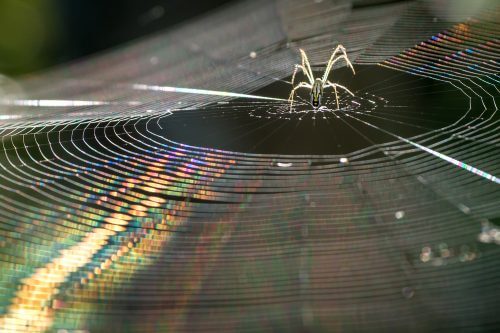Nature has led to the development of protein-based materials with mechanical properties that rival even the best synthetic materials. For example - spider webs are stronger than steel. However, unlike steel, the natural fiber cannot be mass produced. Scientists report a method in which bacteria are able to produce spider webs and other proteins that could be effective during space missions
[Translation by Dr. Nachmani Moshe]
![Engineered bacteria produce spider web proteins that could be used as strong fibers [Courtesy: Christopher Bowen]](https://www.hayadan.org.il/images/content3/2019/04/NM257SpiderSilk.jpg)
Engineered bacteria produce spider web proteins that could be used as strong fibers [Courtesy: Christopher Bowen]
"In nature, there are many protein-based materials with amazing mechanical properties, but the supply of these materials is usually limited," says the lead researcher. "My lab focuses on bacterial engineering, so that we can not only produce these materials but even improve them." If it is possible to mass produce spider webs, then these could be used in a variety of applications, from bulletproof fabrics to surgical sutures. However, the production of spider webs is quite challenging - spiders produce small quantities and certain species become cannibals when grouped together. Therefore, scientists have tried to engineer bacteria, yeast, plants and even goats to produce spider webs, but they have not yet been able to fully replicate the mechanical properties of the fibers produced in nature.
Part of the problem lies in the fact that the proteins that build the spider's web are encoded by extremely long DNA sequences with high repetitions of the segments themselves, this after spiders developed ways to preserve these sequences within their genomes. However, when scientists inserted this type of DNA into other organisms, the genes became unstable, and were even altered by the host's cellular machinery. Researchers from the University of Washington wondered if the long repeating sequences could be cut into shorter segments that the bacteria could use and produce proteins based on. Then, the researchers could connect the shorter proteins to make the longer spider webs.

The research team inserted genes into the bacterium that encode two types of proteins for spider webs, each of which is connected by a sequence known as an 'intron'. These sequences are protein sequences that occur in nature and have enzymatic activity: two such sequences, each at the end of two separate proteins, can bind and then cleave themselves creating a functional whole protein. After inserting the genes, the researchers cleaved the bacterial structure and purified the short parts of the spider web protein. Mixing the short segments caused them to join together using the glue of the ends of the introns to form a complete protein. When this product is turned into fiber, the silk webs produced by the bacteria have all the properties of natural spider webs, including their extraordinary strength, durability and stretchability. The researchers obtained more silk using this method than was produced by spiders (two grams of silk per liter of bacterial culture), and they are currently trying to further increase the efficiency of the process.
The researchers are able to create a variety of proteins simply by changing the DNA of the spider web and inserting other sequences into the bacteria. For example, the researchers used the method to create a protein from muscles that binds tightly to surfaces, a protein that could be used in the future as an underwater glue. Now, the researchers are trying to optimize the process so that the connection reaction of the protein segments can take place inside the bacterial cells themselves. Such a mechanism could improve the efficiency and automation potential of the system and thus the researchers would no longer have to purify the two parts of the protein and only then combine them together. In addition to the applications that will be implemented here on Earth, the system for producing the proteins from the bacteria could be useful during space missions, adds the lead researcher and says: "NASA is one of the bodies that finance us, and they are interested in the field of bio-production," says the researcher. "At the moment researchers at NASA are developing technologies by which it will be possible to convert carbon dioxide into carbohydrates (sugars) that can be used as food for non-engineered bacteria. In this way, astronauts will be able to produce the protein-based materials they require in space without bringing a large amount of raw materials with them from Earth."

4 תגובות
After all, every "protein folding" process requires direction in the form of gravity; The structure and properties of a given protein, produced by any bacteria - on Earth or in space - will be different.
Very interesting article
Very interesting article
Thank you Dr. Moshe Nachmani
The great danger is the possibility of such germs leaking into the open space and there is no knowing where this may develop. When you try to put this into a tender goat, can you watch out for bacteria??
Yehuda